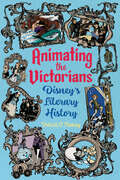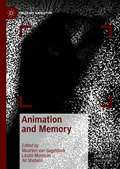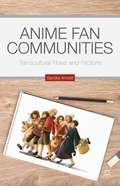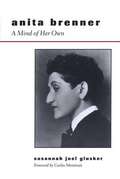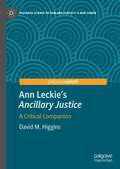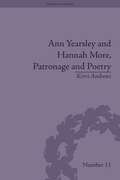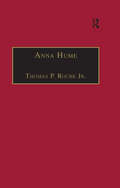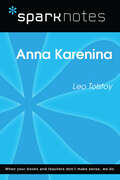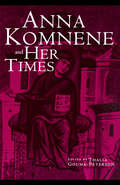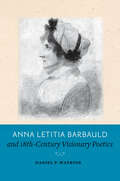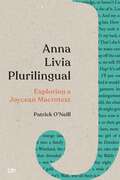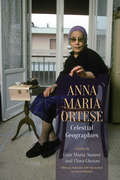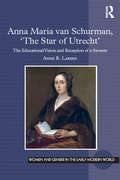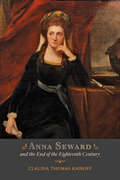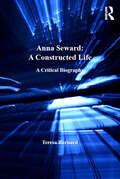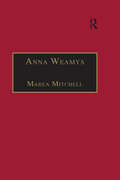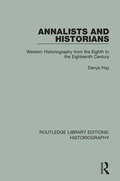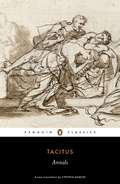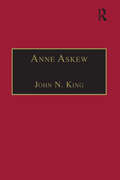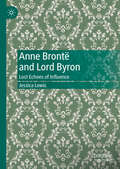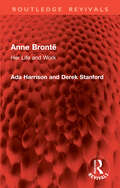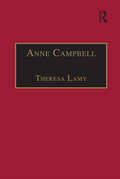- Table View
- List View
Animating the Victorians: Disney's Literary History (Children's Literature Association Series)
by Patrick C. FlemingMany Disney films adapt works from the Victorian period, which is often called the Golden Age of children’s literature. Animating the Victorians: Disney’s Literary History explores Disney’s adaptations of Victorian texts like Alice in Wonderland, Oliver Twist, Treasure Island, Peter Pan, and the tales of Hans Christian Andersen. Author Patrick C. Fleming traces those adaptations from initial concept to theatrical release and beyond to the sequels, consumer products, and theme park attractions that make up a Disney franchise. During the production process, which often extended over decades, Disney’s writers engaged not just with the texts themselves but with the contexts in which they were written, their authors’ biographies, and intervening adaptations. To reveal that process, Fleming draws on preproduction reports, press releases, and unfinished drafts, including materials in the Walt Disney Company Archives, some of which have not yet been discussed in print. But the relationship between Disney and the Victorians goes beyond adaptations. Walt Disney himself had a similar career to the Victorian author-entrepreneur Charles Dickens. Linking the Disney Princess franchise to Victorian ideologies shows how gender and sexuality are constantly being renegotiated. Disney’s animated musicals, theme parks, copyright practices, and even marketing campaigns depend on cultural assumptions, legal frameworks, and media technologies that emerged in nineteenth-century England. Moreover, Disney’s adaptations influence modern students and scholars of the Victorian period. By applying scholarship in Victorian studies to a global company, Fleming shows how institutions mediate our understanding of the past and demonstrates the continued relevance of literary studies in a corporate media age.
Animation and Memory (Palgrave Animation)
by László Munteán Maarten Van Gageldonk Ali ShobeiriThis book examines the role of memory in animation, as well as the ways in which the medium of animation can function as a technology of remembering and forgetting. By doing so, it establishes a platform for the cross-fertilization between the burgeoning fields of animation studies and memory studies. By analyzing a wide range of different animation types, from stop motion to computer animation, and from cell animated cartoons to painted animation, this book explores the ways in which animation can function as a representational medium. The five parts of the book discuss the interrelation of animation and memory through the lens of materiality, corporeality, animation techniques, the city, and animated documentaries. These discussions raise a number of questions: how do animation films bring forth personal and collective pasts? What is the role of found footage, objects, and sound in the material and affective dimensions of animation? How does animation serve political ends? The essays in this volume offer answers to these questions through a wide variety of case studies and contexts. The book will appeal to both a broad academic and a more general readership with an interest in animation studies, memory studies, cultural studies, comparative visual arts, and media studies.
Anime Fan Communities
by Sandra AnnettHow have animation fans in Japan, South Korea, the United States, and Canada formed communities and dealt with conflicts across cultural and geographic distance? This book traces animation fandom from its roots in early cinema audiences, through mid-century children's cartoon fan clubs, to today's digitally-networked transcultural fan cultures.
Anita Brenner: A Mind of Her Own
by Susannah Joel GluskerJournalist, historian, anthropologist, art critic, and creative writer, Anita Brenner was one of Mexico's most discerning interpreters. In this book, her daughter, Susannah Glusker, traces Brenner's intellectual growth and achievements from the 1920s through the 1940s. This intellectual biography brings to light a complex, fascinating woman who bridged many worlds--the United States and Mexico, art and politics, professional work and family life. Journalist, historian, anthropologist, art critic, and creative writer, Anita Brenner was one of Mexico's most discerning interpreters. Born to a Jewish immigrant family in Mexico a few years before the Revolution of 1910, she matured into an independent liberal who defended Mexico, workers, and all those who were treated unfairly, whatever their origin or nationality. In this book, her daughter, Susannah Glusker, traces Brenner's intellectual growth and achievements from the 1920s through the 1940s. Drawing on Brenner's unpublished journals and autobiographical novel, as well as on her published writing, Glusker describes the origin and impact of Brenner's three major books, Idols Behind Altars, Your Mexican Holiday, and The Wind That Swept Mexico. Along the way, Glusker traces Brenner's support of many liberal causes, including her championship of Mexico as a haven for Jewish immigrants in the early 1920s. This intellectual biography brings to light a complex, fascinating woman who bridged many worlds--the United States and Mexico, art and politics, professional work and family life.
Anita and Me
by Meera SyalThis is the story of Meena the nine-year-old, daughter of the only Punjabi family in the mining village of Tollington. A vision of British childhood in the 1960s, caught between two cultures, each on the edge of enormous change is portrayed here.
Ann Leckie’s "Ancillary Justice": A Critical Companion (Palgrave Science Fiction and Fantasy: A New Canon)
by David M. HigginsThis book argues that Ann Leckie’s novel Ancillary Justice offers a devastating rebuke to the political, social, cultural, and economic injustices of American imperialism in the post 9/11 era. Following an introductory overview, the study offers four chapters that examine key themes central to the novel: gender, imperial economics, race, and revolutionary agency. Ancillary Justice’s exploration of these four themes, and the way it reveals how these issues are all fundamentally entangled with the problem of contemporary imperial power, warrants its status as a canonical work of science fiction for the twenty-first century. The book concludes with a brief interview with Leckie herself touching on each of the topics examined during the preceding chapters.
Ann Radcliffe, Romanticism and the Gothic
by Angela Wright Dale TownshendThis book offers unique and fresh perspectives upon the literary productions of one of the most highly remunerated and widely admired authors of the Romantic period, Ann Radcliffe (1764 1823). While drawing upon, consolidating and enriching the critical impulses reflected in Radcliffe scholarship to date, this collection of essays, composed by a range of renowned scholars of the Romantic period, also foregrounds the hitherto neglected aspects of the author's work. Radcliffe's relations to Romantic-era travel writing; the complex political ideologies that lie behind her historiographic endeavours; her poetry and its relation to institutionalised forms of Romanticism; and her literary connections to eighteenth-century women's writing are all examined in this collection. Offering fresh considerations of the well-known Gothic fictions and extending the appreciation of Radcliffe in new critical directions, the collection reappraises Radcliffe's full oeuvre within the wider literary and political contexts of her time.
Ann Yearsley and Hannah More, Patronage and Poetry: The Story of a Literary Relationship (Gender and Genre #11)
by Kerri AndrewsThis study offers a timely and necessary reassessment of the careers of Ann Yearsley and Hannah More. Making use of newly-discovered letters and poems, Andrews provides a full analysis of the breakdown of the two writers’ affiliation and compares it to other labouring-class relationships based on patronage.
Anna Hume: Printed Writings 1641–1700: Series II, Part Three, Volume 8 (The Early Modern Englishwoman: A Facsimile Library of Essential Works & Printed Writings, 1641-1700: Series II, Part Three)
by Thomas P. Jr.Little is known of Anna Hume except as the translator of the first three of Petrach's Trionfi and also as the daughter of David Hume of Godscroft whose History of the Houses of Douglas and Angus she edited in one of its troubled versions. This volume reprints her translation of Petrarch's The Triumphs of Love - a series of six poems celebrating Petrarch's purported devotion to Laura. The poems tell a tale of Love's triumph over the poet, superseded by the triumph of chastity (in that Laura did not yield to Petrarch's love) which is in turn superseded by the triumph of death over Laura. Hume's 1644 translation is reproduced here with five related texts as appendices - an emblem and poem by Robert Farley; the translation of The Triumph of Eternitie by Elizabeth I; the translation of The Triumph of Death by Mary Sidney Herbert; illustrations from Il Petrarcha con l'espositione di M. Alessandro Vellutello...and the translation of lines 102-172 of The Triumph of Death by Barbarina Ogle Brand, Lady Dacre.
Anna Karenina (SparkNotes Literature Guide Series)
by SparkNotesAnna Karenina (SparkNotes Literature Guide) by Leo Tolstoy Making the reading experience fun! Created by Harvard students for students everywhere, SparkNotes is a new breed of study guide: smarter, better, faster. Geared to what today's students need to know, SparkNotes provides: chapter-by-chapter analysis explanations of key themes, motifs, and symbols a review quiz and essay topics Lively and accessible, these guides are perfect for late-night studying and writing papers.
Anna Komnene and Her Times (Garland Medieval Casebooks #Vol. 29)
by Thalia Gouma-PetersonThis significant critical anthology explores the life of Anna Komnene, the Byzantine context in which she wrote, and the impact of the Alexiad on her times and on subsequent historical works of literature.
Anna Letitia Barbauld and Eighteenth-Century Visionary Poetics
by Daniel P. WatkinsIn this first critical study of Anna Letitia Barbauld’s major work, Daniel P. Watkins reveals the singular purpose of Barbauld’s visionary poems: to recreate the world based on the values of liberty and justice. Watkins examines in close detail both the form and content of Barbauld’s Poems, originally published in 1773 and revised and reissued in 1792. Along with careful readings of the poems that situate the works in their broader political, historical, and philosophical contexts, Watkins explores the relevance of the introductory epigraphs and the importance of the poems’ placement throughout the volume. Centering his study on Barbauld’s effort to develop a visionary poetic stance, Watkins argues that the deliberate arrangement of the poems creates a coherent portrayal of Barbauld’s poetic, political, and social vision, a far-sighted sagacity born of her deep belief that the principles of love, sympathy, liberty, and pacifism are necessary for a secure and meaningful human reality. In tracing the contours of this effort, Watkins examines, in particular, the tension in Barbauld’s poetry between her desire to engage directly with the political realities of the world and her equally strong longing for a pastoral world of peace and prosperity. Scholars of British literature and women writers will welcome this important study of one of the eighteenth century’s foremost writers.
Anna Livia Plurilingual: Exploring a Joycean Macrotext
by Patrick O'NeillThe complexity of James Joyce’s Finnegans Wake ensures that it cannot be translated; rather, it can only be rewritten. These rewritings vary significantly, and the extent of their differences – both within individual target languages and across multiple languages – invites further exploration.Anna Livia Plurilingual is a study of a Joycean macrotext that provides a detailed comparative analysis of multiple translations of selected excerpts from Joyce’s iconic Anna Livia Plurabelle (1928), which was later incorporated into Finnegans Wake (1939). Patrick O’Neill examines how these translations function as independent texts rather than mere derivatives of the original, highlighting the creative and interpretative choices made by translators.While the concept of a literary macrotext could in principle encompass all reader responses, this work specifically focuses on translations, emphasizing comparative readings of the original text alongside its diverse interpretations. O’Neill’s investigation not only illuminates the intricacies of Joyce’s language and the complexities of the resulting macrotext but also offers valuable insights into the broader field of literary translation studies.
Anna Maria Ortese
by Gian Maria Annovi Flora GhezzoAfter years of obscurity, Anna Maria Ortese (1914-1998) is emerging as one of the most important Italian authors of the twentieth-century, taking her place alongside such luminaries as Italo Calvino, Primo Levi, and Elsa Morante. Anna Maria Ortese: Celestial Geographies features a selection of essays by established Ortese scholars that trace her remarkable creative trajectory.Bringing a wide range of critical perspectives to Ortese's work, the contributors to this collection map the author's complex textual geography, with its overlapping literary genres, forms, and conceptual categories, and the rhetorical and narrative strategies that pervade Ortese's many types of writing. The essays are complemented by material translated here for the first time: Ortese's unpublished letters to her mentor, the writer Massimo Bontempelli; and an extended interview with Ortese by fellow Italian novelist Dacia Maraini.
Anna Maria van Schurman, 'The Star of Utrecht': The Educational Vision and Reception of a Savante (Women and Gender in the Early Modern World)
by Anne R. LarsenDutch Golden Age scholar Anna Maria van Schurman was widely regarded throughout the seventeenth century as the most learned woman of her age. She was 'The Star of Utrecht','The Dutch Minerva','The Tenth Muse', 'a miracle of her sex', 'the incomparable Virgin', and 'the oracle of Utrecht'. As the first woman ever to attend a university, she was also the first to advocate, boldly, that women should be admitted into universities. A brilliant linguist, she mastered some fifteen languages. She was the first Dutch woman to seek publication of her correspondence. Her letters in several languages Hebrew, Greek, Latin, and French – to the intellectual men and women of her time reveal the breadth of her interests in theology, philosophy, medicine, literature, numismatics, painting, sculpture, embroidery, and instrumental music. This study addresses Van Schurman's transformative contribution to the seventeenth-century debate on women's education. It analyses, first, her educational philosophy; and, second, the transnational reception of her writings on women's education, particularly in France. Anne Larsen explores how, in advocating advanced learning for women, Van Schurman challenged the educational establishment of her day to allow women to study all the arts and the sciences. Her letters offer fascinating insights into the challenges that scholarly women faced in the early modern period when they sought to define themselves as intellectuals, writers, and thoughtful contributors to the social good.
Anna Seward and the End of the Eighteenth Century
by Claudia T. KairoffAnna Seward and her career defy easy placement into the traditional periods of British literature. Raised to emulate the great poets John Milton and Alexander Pope, maturing in the Age of Sensibility, and publishing during the early Romantic era, Seward exemplifies the eighteenth-century transition from classical to Romantic. Claudia Thomas Kairoff’s excellent critical study offers fresh readings of Anna Seward’s most important writings and firmly establishes the poet as a pivotal figure among late-century British writers. Reading Seward’s writing alongside recent scholarship on gendered conceptions of the poetic career, patriotism, provincial culture, sensibility, and the sonnet revival, Kairoff carefully reconsiders Seward’s poetry and critical prose. Written as it was in the last decades of the eighteenth century, Seward’s work does not comfortably fit into the dominant models of Enlightenment-era verse or the tropes that characterize Romantic poetry. Rather than seeing this as an obstacle for understanding Seward’s writing within a particular literary style, Kairoff argues that this allows readers to see in Seward’s works the eighteenth-century roots of Romantic-era poetry. Arguably the most prominent woman poet of her lifetime, Seward’s writings disappeared from popular and scholarly view shortly after her death. After nearly two hundred years of critical neglect, Seward is attracting renewed attention, and with this book Kairoff makes a strong and convincing case for including Anna Seward's remarkable literary achievements among the most important of the late eighteenth century.
Anna Seward and the End of the Eighteenth Century
by Claudia T. KairoffA critical study of the prominent British poet’s work.Anna Seward and her career defy easy placement into the traditional periods of British literature. Raised to emulate the great poets John Milton and Alexander Pope, maturing in the Age of Sensibility, and publishing during the early Romantic era, Seward exemplifies the eighteenth-century transition from classical to Romantic. Claudia Thomas Kairoff’s excellent critical study offers fresh readings of Anna Seward's most important writings and firmly establishes the poet as a pivotal figure among late-century British writers.Reading Seward’s writing alongside recent scholarship on gendered conceptions of the poetic career, patriotism, provincial culture, sensibility, and the sonnet revival, Kairoff carefully reconsiders Seward's poetry and critical prose. Written as it was in the last decades of the eighteenth century, Seward’s work does not comfortably fit into the dominant models of Enlightenment-era verse or the tropes that characterize Romantic poetry. Rather than seeing this as an obstacle for understanding Seward’s writing within a particular literary style, Kairoff argues that this allows readers to see in Seward's works the eighteenth-century roots of Romantic-era poetry.Arguably the most prominent woman poet of her lifetime, Seward’s writings disappeared from popular and scholarly view shortly after her death. After nearly two hundred years of critical neglect, Seward is attracting renewed attention, and with this book Kairoff makes a strong and convincing case for including Anna Seward’s remarkable literary achievements among the most important of the late eighteenth century.“Professor Kairoff achieves her goal of providing “fresh readings, in a richer context,” which will go a long way toward reestablishing Seward’s importance. The book is a significant contribution to literary scholarship and will be widely read, cited, and admired.” —Paula R. Feldman“This lucid, stimulating study will challenge traditional notions not only of Seward but also of the interstice of Romanticism and late-century women authors.” —Choice“Kairoff effectively demonstrates the quality of Seward’s work, and articulates some of the ways in which a reappraisal of Seward might enrich our understanding of both eighteenth-century and Romantic-era literary cultures, and our conception of the writing practices of both male and female authors.” —Years Work in English Studies
Anna Seward: A Critical Biography
by Teresa BarnardIn her critical biography of Anna Seward (1742-1809), Teresa Barnard examines the poet's unpublished letters and manuscripts, providing a fresh perspective on Seward's life and historical milieu that restores and problematizes Seward's carefully constructed narrative of her life. Of the poet Anna Seward, it may be said with some veracity that hers was an epistolary life. What is known of Seward comes from six volumes of her letters and from juvenile letters that prefaced her books of poetry, all published posthumously. That Seward intended her correspondence to serve as her autobiography is clear, but she could not have anticipated that the letters she intended for publication would be drastically edited and censored by her literary editor, Walter Scott, and by her publisher, Archibald Constable. Stripped of their vitality and much of their significance, the published letters omit telling tales of the intricacies of the marriage market and Seward's own battles against gender inequality in the educational and workplace spheres. Seward's correspondents included Erasmus Darwin, William Hayley, Helen Maria Williams, and Robert Southey, and her letters are packed with stories and anecdotes about her friends' lives and characters, what they looked like, and how they lived. Particularly compelling is Barnard's discussion of Seward's astonishing last will and testament, a twenty-page document that summarizes her life, achievements, and self-definition as a writing woman. Barnard's biography not only challenges what is known about Seward, but provides new information about the lives and times of eighteenth-century writers.
Anna Weamys: Printed Writings 1641–1700: Series II, Part Three, Volume 7 (The Early Modern Englishwoman: A Facsimile Library of Essential Works & Printed Writings, 1641-1700: Series II, Part Three #Vol. 7)
by Marea MitchellThe title page of the 1651 continuation of Sir Philip Sidney's Arcadia, which is made available in facsimile in this volume, designates its author as 'Mris A. W.' It is now the convention to attribute the volume to Anna Weamys. Little is known about the author; the only other information about her is suggested by the substantial number of commendatory verses which precede the text. Though details about her and the specific motivations for continuing Sidney's work remain tantalisingly absent, Anna Weamys's text is important for understanding the reception of Sidney by women readers, as well as the development of prose fiction as it evolved towards the novel. Its female heroines illustrate a real concern with how women might navigate the straits of female behaviour in a judgmental and partisan society. The Introductory Note to this volume provides some analysis of how gender, class, and historical and cultural values affect what Weamys chose to pick up from Sidney's work and what seems to be of lesser interest to her. For example, in the three stories from Sidney's Arcadia on which she focuses, Weamys brings an awareness of the difficulties of women's position to bear on narrative in a way which prefigures the novel.
Annalists and Historians: Western Historiography from the VIIIth to the XVIIIth Century (Routledge Library Editions: Historiography #17)
by Denys HayThis book, originally published in 1977, is a survey of European historiography from its origins in the historians of Greece and Rome, through the annalists and chroniclers of the middle ages, to the historians of the late eighteenth century. The author concentrates on those writers whose works fit into a specific category of writing, or who have inlfuence the course of later historical writing, though he does deal with some of the more specialist forms of medieval historiography such as the crusading writers, and chivalrous historians like Froissart. He maintains that ‘modern’ history did not develop until the 18th Century.
Annals
by TacitusA compelling new translation of Tacitus' Annals, one of the greatest accounts of ancient Rome, by Cynthia Damon.Tacitus' Annals recounts the major historical events from the years shortly before the death of Augustus to the death of Nero in AD 68. With clarity and vivid intensity Tacitus describes the reign of terror under the corrupt Tiberius, the great fire of Rome during the time of Nero and the wars, poisonings, scandals, conspiracies and murders that were part of imperial life. Despite his claim that the Annals were written objectively, Tacitus' account is sharply critical of the emperors' excesses and fearful for the future of imperial Rome, while also filled with a longing for its past glories.This new Penguin Classics edition also includes chronologies, notes, appendices, a genealogy and an introduction discussing Tacitus's life and his approach to history.
Anne Askew: Printed Writings 1500–1640: Series 1, Part One, Volume 1 (The Early Modern Englishwoman: A Facsimile Library of Essential Works & Printed Writings, 1500-1640: Series I, Part One #Vol. 1)
by John N. KingAnne Askew (1521-1546) was accused of heresy because of her denial of the Catholic doctrine of transubstantiation and ritual of mass. These two works provide an extremely rare autobiographical account of heresy interrogations, torture, trial and conviction. Her manuscripts were smuggled out of England to John Bale on the Continent who edited and published them in 1545 and 1546 respectively.
Anne Brontë and Lord Byron: Lost Echoes of Influence
by Jessica LewisThis book explores the relationship between Anne Brontë’s work and the life and writings of Lord Byron. Byron’s influence on the other Brontë siblings is well-documented but absent in Anne’s history. Building on recent discourses of rich intertextuality in Anne’s work, Jessica Lewis reveals her relationship with the poet as significantly different from that of her siblings. Instead of trying to emulate Byron or derive inspiration from the concept of ‘mix’d essences’ or elemental affinity, Anne’s relationship with him is grounded in their shared Calvinistic upbringing and a rejection of its stringent principles, which propels both writers to positions of contemporary religious controversy. This volume reappraises Anne Brontë and her work in light of significant Byronic influence, and provides new readings of her novels and poetry.
Anne Brontë: Her Life and Work (Routledge Revivals)
by Derek Stanford Ada HarrisonAlthough the Brontë story had been told many times, originally published in 1959, Ada Harrison and Derek Stanford wrote the first book to be devoted entirely to the life and work of Anne. The youngest of the three famous sisters, Anne was too often regarded as a mere appendage to the more spectacular Emily and Charlotte. Yet her work has stood the test of time no less than theirs. ‘If Anne Brontë had lived ten years longer,’ wrote George Moore, the first important critic to establish a claim for Anne as a writer of consequence, ‘she would have taken a place beside Jane Austen, perhaps even a higher place.’ It is in the light of such statements as this that the authors wrote their critical biography, showing the shy but engaging third sister as a writer and a character in her own right.The story of Anne’s life is told by Ada Harrison, who unfortunately did not live to see proofs of this book; the assessment of Anne’s verse and fiction is undertaken by the poet and critic, Derek Stanford. The issues they raise, and their general conclusions, may be regarded as controversial; but not only have they made a number of original points in this first book on Anne, they have also, by moving the spotlight, shed fresh illumination on the whole Brontë picture.
Anne Campbell: Printed Writings 1500–1640: Series I, Part Four, Volume 4 (The Early Modern Englishwoman: A Facsimile Library of Essential Works & Printed Writings, 1500-1640: Series I, Part Four)
by Theresa LamyThe religious, historical and rhetorical significance of the Confessions written by St. Augustine, Bishop of Hippo, can hardly be overstated: the book is one of the unifying texts of Western Christianity and a seminal work for Roman Catholic Europe. The publication in 1622 of Duchess Anne Campbell's selections in Spanish of parts of Augustine's Confessions has been little remarked, in part at least because of the obscurity of her feat. Yet Campbell's work is worthy of attention because of the evidence it gives of one woman's education and literary interests.
